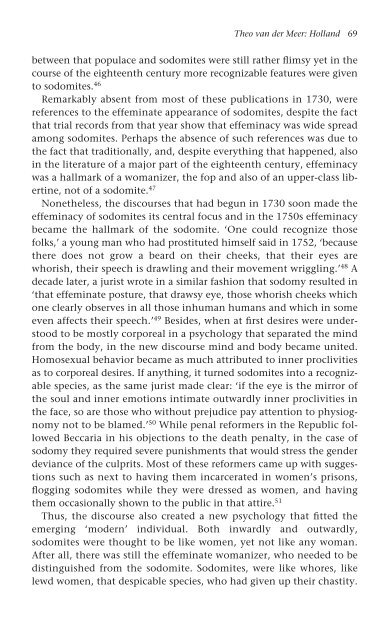queer masculinities
queer masculinities
queer masculinities
Create successful ePaper yourself
Turn your PDF publications into a flip-book with our unique Google optimized e-Paper software.
Theo van der Meer: Holland 69<br />
between that populace and sodomites were still rather flimsy yet in the<br />
course of the eighteenth century more recognizable features were given<br />
to sodomites. 46<br />
Remarkably absent from most of these publications in 1730, were<br />
references to the effeminate appearance of sodomites, despite the fact<br />
that trial records from that year show that effeminacy was wide spread<br />
among sodomites. Perhaps the absence of such references was due to<br />
the fact that traditionally, and, despite everything that happened, also<br />
in the literature of a major part of the eighteenth century, effeminacy<br />
was a hallmark of a womanizer, the fop and also of an upper-class libertine,<br />
not of a sodomite. 47<br />
Nonetheless, the discourses that had begun in 1730 soon made the<br />
effeminacy of sodomites its central focus and in the 1750s effeminacy<br />
became the hallmark of the sodomite. ‘One could recognize those<br />
folks,’ a young man who had prostituted himself said in 1752, ‘because<br />
there does not grow a beard on their cheeks, that their eyes are<br />
whorish, their speech is drawling and their movement wriggling.’ 48 A<br />
decade later, a jurist wrote in a similar fashion that sodomy resulted in<br />
‘that effeminate posture, that drawsy eye, those whorish cheeks which<br />
one clearly observes in all those inhuman humans and which in some<br />
even affects their speech.’ 49 Besides, when at first desires were understood<br />
to be mostly corporeal in a psychology that separated the mind<br />
from the body, in the new discourse mind and body became united.<br />
Homosexual behavior became as much attributed to inner proclivities<br />
as to corporeal desires. If anything, it turned sodomites into a recognizable<br />
species, as the same jurist made clear: ‘if the eye is the mirror of<br />
the soul and inner emotions intimate outwardly inner proclivities in<br />
the face, so are those who without prejudice pay attention to physiognomy<br />
not to be blamed.’ 50 While penal reformers in the Republic followed<br />
Beccaria in his objections to the death penalty, in the case of<br />
sodomy they required severe punishments that would stress the gender<br />
deviance of the culprits. Most of these reformers came up with suggestions<br />
such as next to having them incarcerated in women’s prisons,<br />
flogging sodomites while they were dressed as women, and having<br />
them occasionally shown to the public in that attire. 51<br />
Thus, the discourse also created a new psychology that fitted the<br />
emerging ‘modern’ individual. Both inwardly and outwardly,<br />
sodomites were thought to be like women, yet not like any woman.<br />
After all, there was still the effeminate womanizer, who needed to be<br />
distinguished from the sodomite. Sodomites, were like whores, like<br />
lewd women, that despicable species, who had given up their chastity.


